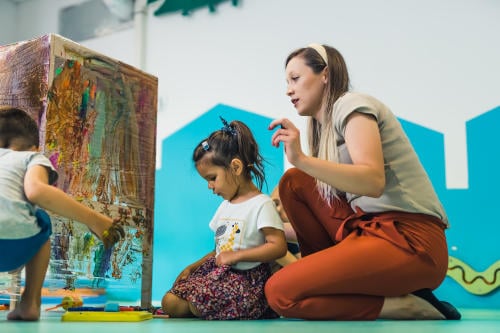Earlier this month, SENsational Tutors attended the TES SEND Show to connect with people who support SEND and discover the latest insights. Milly Allinson, our research copywriter, reports on how inclusivity was a key theme:
Attending the event was an interesting experience for me! I’m a neurodivergent woman who experienced many challenges in the education system and was homeschooled from the age of 9. On the one hand, it was frustrating to hear that neurodivergent students continue to face the same obstacles I once dealt with. However, seeing educators with lived experience of neurodivergence speaking openly about their own struggles was hugely motivating. It was also great to see so many teachers coming forward to build their knowledge of SEND.
If I have one key takeaway from the event, it’s the importance of inclusive teaching, whether that takes place in mainstream classrooms or as part of EOTAS provision.
So, how was inclusive teaching explored within the seminars and how can parents and tutors put the ideas into action?
Inclusive practices for teaching dyslexic students

The first of the two seminars that I attended was “The New Dyslexia Definition: Implementing Targeted Interventions for Dyslexia.” This session explored the updated definition of dyslexia and its potential impact for teachers and students, including identifying characteristics and practical interventions to support learners. The speaker, Emma Saunders, is a dyslexia and SEND specialist and has been a teacher for over 20 years.
Her seminar began with a powerful exploration of her lived experience as a dyslexic student. From a young age, she felt she wasn’t expected to succeed academically. Negative school experiences impacted her self-esteem, for example, she was put on a lower ability table and told she shouldn’t become a nurse as dyslexia would mean she “could give someone the wrong medication”. She described feeling that she didn’t want to bother with studying, as bar charts displaying test scores were displayed in her school. Her scores were about 50% lower than those of other students, which made her feel very unmotivated.
Although I’m not dyslexic myself, I felt a strong connection with Emma’s experiences. I often received negative messaging in school, particularly due to my struggles with information processing, emotional dysregulation and attention due to my AuDHD. Like Emma, I feel this repeated negative messaging affected every area of my life, even outside of education. It was great to see the broader impacts being highlighted.
Emma explored the history of dyslexia, from the first recorded case, Percy F, mentioned in a book by British physician William Pringle Morgan in 1896, to our current understanding. This year, a study by Carroll et al.. highlighted how far our definitions have shifted, as it proposed a new definition for dyslexia. This definition has moved beyond a single cause, such as phonological processing, to address multiple relevant factors, including processing speed and frequent co-occurring developmental differences, like ADHD. It has established a broader, more inclusive definition that acknowledges the individual variability within experiences of dyslexia.
Emma also covered the key characteristics of dyslexia and debunked the myth that dyslexia has set ability levels. Like autism, dyslexia can spread across a spectrum of abilities and challenges. Examples include orthographic (relating to spelling) and phonological (relating to processing sounds) challenges. However, Emma also highlighted the strengths associated with dyslexia, including problem-solving and creativity.
One of the key takeaways from this seminar was the focus on applying inclusive practices for all students.
Emma’s suggestions included techniques from the Orton-Gillingham approach, such as multisensory learning (including visual and auditory) to teach reading and writing, and “overlearning,” which encourages students to continue practising skills after they have attained initial proficiency, as this can improve retention.
For example, SEN Tutor Deanne used multi-sensory messy play to help her student R, who has an acquired brain injury, to learn phonics in a way he found engaging. This helped him to read CVC words and engage in independent play.
These practices can be helpful for all students, helping them to improve their phonetics, for example. Applying inclusive practices across the entire classroom also ensures that dyslexic students are not singled out.
Former SEN teacher Amy describes how she created an inclusive classroom for all students:
“When setting up my classroom, I ensured the environment itself was inclusive to all. This included having quiet spaces to retreat to, and access to spaces and resources for sensory feedback. This was also supported with different types of communication aids, written labels, visuals, talking tins, and photos, so it was clear to everyone what these spaces were used for.
Depending on the needs of the group, I also had a transition tray or bag for each child, which they had ownership over. This included individual sensory resources that could be accessed independently throughout the day and in times of transition. Staff could guide children to engage with these, or the children could request time too. Some children had colouring or Lego, and others had sensory materials like rice and Thera Putty, or visual requests for activities like the use of a yoga ball. It became a culture in the class that everyone had different preferences. Time was built into the timetable for these moments, but some flexibility was also kept for spontaneous support, where needed.”
Supporting AuDHD students in mainstream education

Later in the day, I attended a second seminar, “Understanding and Supporting Children and Young People With the Dual Diagnosis of ADHD and Autism (AuDHD).” This seminar was led by Colin Foley, who is a former SEN teacher, former training director of the ADHD Foundation, and CEO of Neurodiversity Training UK. I was particularly interested in this talk due to my own lived experience. I’d struggled in the mainstream school system and experienced (undiagnosed) AuDHD throughout my school life. I wanted to see whether I’d recognise my own struggles in the seminar – and hopefully learn how AuDHD students will be supported in the future.
Colin spoke about the unique presentation of co-occurring autism and ADHD, and whether it should form a unique diagnostic profile. Although the DSM-5 did not allow this dual diagnosis until 2013, high rates of “AuDHD” are now recognised. From my experience, AuDHD can create unique challenges (and strengths) and these were also explored in the session. For example, AuDHD children often thrive with planning and structure, but also feel a need for spontaneity. This can cause intense internal conflict, as AuDHD people struggle to connect the contradictory needs.
Another key focus of the seminar was attention and executive functioning. Colin argued that the focus on socio-communication challenges in AuDHD should instead move towards an emphasis on executive functioning struggles. Colin also highlighted the positive side of AuDHD attention through “monotropism”, which refers to an information processing style that is acutely focused on a small number of specific interests. This can mean that AuDHD students can concentrate intensely on one particular task (especially if they’re passionate about it) through “hyperfocus.” Colin characterised how mainstream schools can be difficult for AuDHD students, as these students are constantly being pulled out of monotropism during the school day.
At SENsational Tutors, our tutors encourage students to incorporate their special interests into their studies, as this can boost their enjoyment, confidence and working memory. In this example, SEN Tutor Glynda supported P, a student with complex needs, to enjoy learning through their interest in space.
Rather than a “by-the-book” approach where your child is left to engage with the materials alone, SENsational tutors embed these inclusive approaches naturally within sessions. Our tutors learn collaboratively with students, sharing in the inclusive learning experience. This creates a gentler, neuro-inclusive environment for young people to flourish.
Auditory processing, poor working memory, and rejection sensitivity can also make the mainstream school difficult, and Colin encouraged teachers to adjust their practices to be more inclusive. For example, allowing students to speak their thoughts aloud can help with memory and processing, whilst using supportive, compassionate language can reduce rejection sensitivity. Colin spoke about how AuDHD students will often remember negative feedback for a long time, and that it can affect them on a deeper level.
Overall, this seminar took a broad look at the AuDHD profile, encouraging educators to take an inclusive, holistic approach to their students’ needs. Rather than eliminating “behaviours,” the session focused on the internal drivers behind these external presentations and highlighted AuDHD strengths.
Choosing an inclusive school: practical strategies for parents

Inclusive practices for all students, including dyslexic and AuDHD students, are essential to positive SEN learning experiences. They ensure no child is left out or made to feel less capable.
If you’re looking for the right school for your neurodivergent child, then it’s helpful to know what to look for. That’s especially important for neurodivergent young people, who often face more negative experiences in mainstream school. Here are some key inclusive teaching practices to look out for in prospective schools:
Multisensory learning
Teaching reading and writing through multiple senses, including tactile (touch), kinesthetic (movement), auditory and visual supports, is highly beneficial for dyslexic students.
Self-belief
Although it’s often important to reduce demands for neurodivergent students, it’s also essential to help all young people to feel they can reach their full potential. For example, the DfE’s July 2025 writing framework encourages high expectations for all students. This is important, as it ensures SEN students don’t feel less valued or capable of success. However, this needs to be balanced with not pressuring or overfacing students.
Memory and attention
Reviewing learned materials, utilising scaffolds and models, and breaking down tasks can help students who have poor working memory. Providing a clear structure and opportunities for hyperfocus/monotropism on special interests can support students with their attention. We spoke to Colin Foley about how educators can support AuDHD young people with their attentional needs:
“Truly inclusive educational practice for neurodivergent learners has to include an understanding that how and why we attend to different activities in class goes beyond the idea that learners with ADHD can’t pay attention, or that autistic learners can only pay attention to restricted things. The how and why of attention is much more interesting than that – and much more positive.
A good starting point is for educators to reflect upon what they are asking neurodivergent learners to attend to, for how long? And in what way? There are a range of modes of attention, and shifting between too many quickly in a lesson can be anxiety-inducing. Preparation time, spacing, processing time and opportunities to reflect and externalise thinking have to be key ingredients in lesson planning to maximise the potential that lies in hyperfocus and monotropism.”
Auditory/information processing
In his seminar, Colin used the phrase, “You talk less, they talk more.” In essence, schools should provide space to let AuDHD students express their thoughts, as they may struggle more with processing information.
SENsational Tutors’ experienced SEN tutors put a variety of inclusive methods into practice to support information retention in their sessions.
For example, Jane used mind maps to help L, a 16-year-old student with ADHD, remember information for his English Literature and History revision. This led to a fantastic outcome, with L achieving more GCSEs than he needed to progress to his B-Tech course.
Rejection sensitivity
Many AuDHD students struggle with rejection sensitivity, so it’s essential that teachers are aware of its impact – and how a compassionate approach and careful use of language can avoid emotionally overloading these students.
Effective learning for all students
In her session, Emma Saunders highlighted the importance of integrating interventions for dyslexic students into the wider curriculum. Inclusive solutions for neurodivergent children can benefit all young people by having their needs met at school.
At SENsational Tutors, all of our tutors are qualified teachers with 5+ years of SEN experience. To get tailored support, take a look at our Find a Tutor Page or book a free consultation to discuss your needs.



